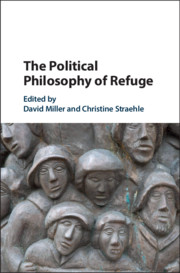Book contents
- The Political Philosophy of Refuge
- The Political Philosophy of Refuge
- Copyright page
- Contents
- Contributors
- Introduction
- Chapter 1 Differentiating Refugees
- Chapter 2 The State’s Right to Exclude Asylum-Seekers and (Some) Refugees
- Chapter 3 Asylum, Speech, and Tragedy
- Chapter 4 Border Rescue
- Chapter 5 Selecting Refugees
- Chapter 6 Refugees and the Right to Remain
- Chapter 7 The Duties of Refugees
- Chapter 8 Is Return the Preferred Solution to Refugee Crises?
- Chapter 9 Refugees and the Right to Return
- Chapter 10 Refugees, Rescue, and Choice
- Chapter 11 Philosophical Foundations for Complementary Protection
- Chapter 12 The Ethics of Sanctuary Policies in Liberal Democratic States
- Bibliography
- Index
Introduction
Published online by Cambridge University Press: 01 November 2019
- The Political Philosophy of Refuge
- The Political Philosophy of Refuge
- Copyright page
- Contents
- Contributors
- Introduction
- Chapter 1 Differentiating Refugees
- Chapter 2 The State’s Right to Exclude Asylum-Seekers and (Some) Refugees
- Chapter 3 Asylum, Speech, and Tragedy
- Chapter 4 Border Rescue
- Chapter 5 Selecting Refugees
- Chapter 6 Refugees and the Right to Remain
- Chapter 7 The Duties of Refugees
- Chapter 8 Is Return the Preferred Solution to Refugee Crises?
- Chapter 9 Refugees and the Right to Return
- Chapter 10 Refugees, Rescue, and Choice
- Chapter 11 Philosophical Foundations for Complementary Protection
- Chapter 12 The Ethics of Sanctuary Policies in Liberal Democratic States
- Bibliography
- Index
Summary
Of the cast of characters who populate the contemporary world, none is more familiar than the figure of the refugee. He or she is visible to us mainly as a person on the move, the victim of war or ethnic cleansing. We see her sitting surrounded by her life’s possessions in a battered truck crossing the wasteland; we see him strapped into an orange lifejacket and crammed precariously on an inflatable raft; we see her waiting sorrowfully in front of a border fence hoping that a guard will one day let her cross. But our remotely acquired visual impressions can mislead. Refugees who are actively in flight make up only a small fraction of the number who qualify for that designation at any moment. The vast majority – some 25 million – are more or less stationary, living largely out of our sight in the global South, in encampments that are purpose-built or home-made, or on the margins of cities like Beirut or Peshawar. They exist in a kind of limbo, often unwelcome visitors in the countries that have little choice but to house them, but unable to return to their homelands while conditions there remain hostile or unsafe. Many would prefer to be resettled in rich, developed countries – typically more than half a million apply to do so each year. But the number who succeed is only a fraction of this, since the governments of these countries set quotas for accepting refugees and go to considerable lengths to enforce them. The events of 2015, when more than a million migrants, including many refugees, entered Europe directly and found sanctuary there, were unprecedented in the recent past, and are unlikely to be repeated. Yet, for citizens in Europe and North America, it is the minority who attempt to settle in the global North who capture most of their attention, and philosophical reflection on the moral and political claims of the refugee, of the kind that occupies this book, has also focussed mainly on those who seek admission to rich developed countries.
- Type
- Chapter
- Information
- The Political Philosophy of Refuge , pp. 1 - 18Publisher: Cambridge University PressPrint publication year: 2019

